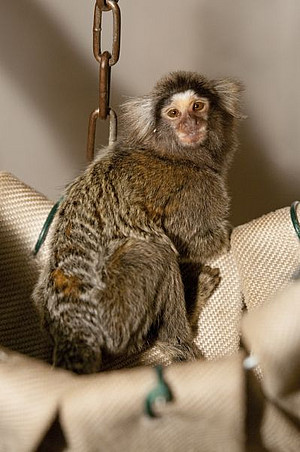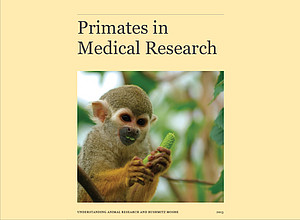Animal experimental research with non-human primates – as in all research with vertebrates – is strictly regulated by law and exactly defined in the national animal welfare law. Certain primate species are explicitly mentioned in the EU animal welfare guideline, which is based on the German animal welfare legislation. Some of these are also implemented at DPZ. In order to get an idea of the type and purpose of experiments with non-human primates at the German Primate Center, you will find information on the species and the respective research in the list on the right (you can click directly on the respective species).
As a general note: Since 2002, biomedical research on great apes (gorillas, chimpanzees, bonobos, orang-utans and gibbons) has been banned throughout Europe and thus also at the German Primate Center. In the past, the DPZ never kept apes or used them in research.
Rhesus monkeys (Macaca mulatta)
Rhesus monkeys (Macaca mulatta) are a primate species of the genus Macaca from the family of Old World monkeys (Cercopithecidae). The natural habitat of rhesus monkeys is Asia and they are not threatened with extinction. The DPZ houses 639 animals (12-31-2021) that mostly live in breeding groups. Only very few of them are actively involved in the research. Rhesus monkeys are used in two research areas of the DPZ: they are suitable animal models for infection research and neuroscience.
Infection Research
In the Infection Research Section, rhesus monkeys have recently been used for research on viruses such as HIV, influenza and Ebola.
In the area of infection research, it is necessary, if all alternative methods for the examination of a research question have been tried, to test the respective approach for the research of a virus or bacterium on an animal. It is necessary to infect only a small number of rhesus monkeys. The animals are always under veterinary supervision and must not live longer with the disease than absolutely necessary. The animals are usually euthanized when the experiment is concluded.
The infection of rhesus monkeys with the simian immunodeficiency virus SIV represents an important animal model for human HIV infection. The genome structures of the two viruses are similar. In SIV infections of rhesus monkeys, essential aspects of the disease development and the course of the disease are similar to that of a human HIV infection. Both vaccines and prophylaxis methods to protect against HIV infection are researched.
Rhesus monkeys are also important models for research on the influenza virus (the flu). Before the DPZ infection biologists conduct research on rhesus monkeys, they perform preparatory work in cell culture to identify host cell enzymes, which are important for the reproduction of influenza viruses. Their importance for the viral spread and the development of the disease must then be clarified, for example with the help of the monkeys.
Another virus that is researched with the aid of rhesus monkeys is herpes. Since 2011, DPZ scientists have been working on various aspects of the infection.
DPZ scientists also perform research on rhesus monkeys with bacteria that cause illness in humans. Helicobacter pylori is an example of such a bacterium. It triggers various bowel diseases in humans, including stomach ulcers and stomach cancer.
Neuroscience

Macaques are also ideal models to study the neuro- and psychophysiological fundamentals of the central nervous system. Since their brains and the visual system are very similar to that of humans, it is possible to use rhesus macaques to gain insights into the brain function of humans.
The neuroscientists at the DPZ apply electrophysiological techniques with the use of electrodes implanted in the brain of the rhesus monkeys to emit the electrical currents from nerve cells depending on the activity of the animal. In order to implant the hair-thin electrodes, the rhesus monkeys must be operated under general anesthesia. Since there are no pain receptors in the brain, they cannot feel the electrodes. Because the animals have to be trained for the movements they are supposed to perform for the experiment, only a few rhesus monkeys are needed for such studies. Such animals can repeatedly implemented in different experiments.
The DPZ scientists use these methods to study questions on attention and motion planning. With that, they would like to know how the brain focuses on a single object next to countless objects that lie or move in the field of vision – for example a football. Findings that stem from these questions are applicable in a further research field of the DPZ: the development of neuroprosthetics. These prosthetics, for example intended to help quadriplegics to control robotic arms by simply thinking about the movement of the prosthetics. A decoder reads these "commands" from the brain and passes it to the robotic arm.
A further neuroscientific research area, in which rhesus monkeys are used, is magnetic resonance imaging (MRI). The Functional Imaging Unit at the DPZ uses this method to gain insight into the structure and function of the living organism. The scientists want to further develop and optimize the method. Using the high-resolution images, various diseases can be investigated in the animal model and the diagnosis in humans can be improved. Therefore, rhesus monkeys and also smaller species of primates, such as common marmosets, and human volunteers are used. The imaging methods are non-invasive. This means that no surgical intervention has to be carried out on the animal.
Common marmoset (Callithrix jacchus)
Common marmosets (Callithrix jacchus) are the second primate species used as an important model for many research areas of at the DPZ. This species of New World monkeys (Callithrichidae) is native to South America and lives mainly in northeastern Brazil. The species can adapt easily and is not threatened with extinction. At the DPZ 482 common marmosets live in breeding groups (12-31-2021).
Stem Cell Biology
The stem cell biologists of the DPZ use common marmosets for their research on embryonic and induced pluripotent stem cells. In accordance with the 3R principle, the scientists of this department have developed methods for the non-invasive or minimally invasive production of preimplantation of embryos. As a general rule, this means that the stem cell biologists retrieve embryos from the womb without any surgical procedure. The regenerative medicine with stem cells could renew the treatment approaches for severe diseases such as a heart attack or diabetes: scientists are working on methods to replace dead or defective body cells with stem cells ("Jack of all trades"), that will continue to develop as healthy "specialist cells".
In addition, the scientists of the research platform Degenerative Diseases are investigating the methodological and reproductive biological basis for the genetic modification of common marmosets. The genetically modified animals carry a so-called GFP gene (green fluorescent protein). At the moment, these are feasibility studies on the introduction and heredity of a transgene in primates. Furthermore, the GFP transgenic animals can be used in follow-up studies to carry out work on embryonic development of the common marmosets and on the feasibility of new forms of therapy aimed at "repairing" disease-causing changes in genetic information (DNA) in body cells. At the DPZ there are 29 transgenic common marmosets (06-30-2020). The animals carrying a GFP gene have no recognizable health impairments, are fertile and cannot be distinguished externally from the "normal" animals.
Infection Pathology
Common marmosets are currently used in two research projects in the Pathology Unit. On the one hand, they are used to research orthopoxvirus infections. The viruses originate from the orthopoxvirus that trigger the human pox illness. Although these have been considered eradicated since the end of the 1970s, a transfer of smallpox varieties from animals to humans cannot be ruled out. Currently experiments are performed on the “Calpox virus”, a variant of the cowpox virus which was just recently discovered by employees in the department. The aim of the scientists is to find out whether they can further develop vaccines against orthopox.
A further field of research of DPZ scientists is the research of respiratory diseases COPD ("chronic obstructive pulmonary disease") and asthma. During this research, the infection pathologists have discovered that common marmosets are a highly suitable model for the research of these human diseases. Common marmosets can therefore be implemented in the development of drugs and therapies for COPD and asthma. The scientists used step by step alternative methods (in vitro results = from the test tube as well as ex vivo studies = studies with tissue samples), until the implementation of the living common marmosets are necessary. By using this method, the numbers of animals for experiments is significantly reduced, so that the 3R principle is taken into account.
Long-tailed macaque (Macaca fascicularis)
The cynomolgus or long-tailed macaque (Macaca fascicularis) are found in the wild in many Southeast Asian countries from Thailand to the Philippines and are highly adaptable. They are closely related to the rhesus macaques. The species is not directly threatened in its existence.
Cynomolgus macaques form a small part of the DPZ primate population. There is currently a breeding group of 67 animals (12-31-2021) that are used by the Cognitive Ethology Laboratory for various behavioral studies.
However, cynomolgus macaques are relatively often used for research purposes in Germany. This includes statutory safety tests for medication, but tests of this kind do not take place at the DPZ.
In the Infection Biology Department, cynomolgus macaques have recently been used to study the prion disease CWD (Chronic Wasting Disease). CWD is a disease in deer that is similar to the human Creutzfeldt-Jakob disease.
Hamadryas baboons (Papio hamadryas)
Hamadryas baboons (Papio hamadryas) from the genus baboons, originate from the family of the Old World monkeys (Cercopithecidae). They live in Northeast Africa and the Arabian Peninsula and are assessed by the IUCN as a low-risk endangered species. The breeding group of 68 animals (12-31-2021) is mainly available to cover the scientific needs for these animals in Germany. On baboons, immune responses are investigated after organ transplantations. Since 2012, the DPZ has been involved in the Transregional Collaborative Research Center 127 funded by the German Research Society (DFG), which is dedicated to research on xenotransplantation. Xenotransplantation means the transplantation of cells, tissues or organs between species which are phylogenetically not closely related, from animal to animal as well as from animal to human. The DPZ works closely with the University Hospital in Munich, where heart and heart tissue transplants as well as transplants of the insulin-producing cells of the pig's pancreas are being studied. Pig organs and tissues are well suited to replace human organs and tissues since they are very similar anatomically and physiologically. To check whether organs are safe and effective, experiments with baboons are necessary. The DPZ provides the animals for the difficult transplantations and also helps to carry out technically simpler procedures with tissues - for example insulin-producing pancreatic cells. Also the aftercare of the animals after the surgery, which is not easy, takes place in the DPZ.
In general, baboons are also used as model organism to investigate the neurophysiological basis for the emergence of epilepsy and schizophrenia. In addition, therapies for cardiovascular diseases are developed with the aid of this animal model. However, such research projects are not carried out at DPZ.
Primate species
Rhesus monkeys (Macaca mulatta)
Long-tailed macaques (Macaca fascicularis)
The interactive tour takes visitors through the DPZ's husbandry and breeding grounds and provides important information on monkey species, hygiene regulations and the daily work of veterinarians, animal caretakers and scientists.
Further information
A new, free iBook titled "Primates in Medical Research" is now available via iTunes and as download. The book was written by primate veterinarian Moshe Bushmitz and experts from Understanding Animal Research and focuses on the following questions: How do researchers work with primates? Which species do they use? What has research with primates revealed? How are the primates looked after?







